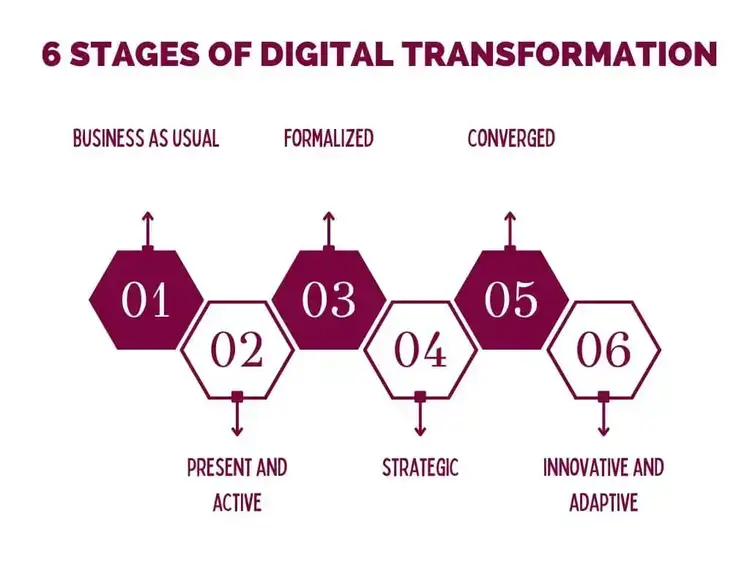In today’s fast-paced digital landscape, organizations across industries are embarking on a transformative journey known as digital transformation. The path to its achievement is neither linear nor one-size-fits-all; it requires careful planning and consistent implementation. To increase the probability of success, businesses should be able to identify distinct stages of digital transformation to apply to their overall strategy.
In this article, we will go through the most common six stages of digital transformation, thus providing a comprehensive understanding of each phase and the value it brings to businesses. From the initial stages of laying the foundation to the advanced stages of convergence and innovation, we explore how your organizations can navigate this transformative journey, enabling you to harness the full potential of digital technologies. Let’s dive in!
Table of Contents
What Is a Stage of Digital Transformation
Digital transformation is a comprehensive process that involves integrating digital technologies into all aspects of a business to create new – or modify – business processes, culture, and customer experiences to meet changing business and market requirements.

As we move from traditional and manual works from paper to smart applications, digital transformation goes beyond adopting new technologies; it encompasses a cultural shift where you have a chance to reimagine how you do business, from operational enhancements to strategic realignment. This process aims to enhance efficiency, improve customer experiences, and stay competitive in an increasingly digital world.
A stage of digital transformation is a distinct phase or step within the overall digital transformation process. Each phase represents a distinct set of activities and objectives designed to achieve transformation objectives. They serve as a blueprint for a purposeful and advantageous digital transformation. You can use it to validate, benchmark, and map your organization’s progress toward digital literacy and leadership, which may result in an effective digital transformation strategy and substantial business growth.
6 Stages of Digital Transformation
The breakdown of the digital transformation process may vary from one framework or model to another. It can be divided into 3, 4, or 6 stages depending on what terms are used to describe each stage. For example, Havard Business Review identified 3 distinct stages of the digital learning curve, namely Modernization, Enterprise-wide transformation, and New business creation; while the FourWeekMBA organization developed 4 stages of digital transformation, which were classified into Digitally-enabled, Digitally-enhanced, Tech/Platform business models, and Business Ecosystems.

In this article, we will assess a common breakdown of the process, which involves 6 stages of digital transformation. Each stage represents a different level of maturity and capability, progressing from business as usual, when a company begins its digital transformation, to innovative and adaptive, when the transformation is complete and the organization has embraced the change.
Business as Usual
At the initial stage of digital transformation, businesses are operating in a traditional manner that is typically associated with manual or paper-based processes. In this phase, they have limited reliance on digital technologies and a resistance to change.
Here, technology is primarily used to facilitate existing processes and functions. Digital initiatives frequently lack strategic focus, and technology adoption is driven by immediate needs rather than long-term objectives. At this stage, organizations lack a comprehensive understanding of the potential benefits and opportunities offered by digital transformation.
Present and Active
In the second stage, organizations become more aware of the significance of digital technologies and start actively investing in them. Digital initiatives are scattered across different departments, and there’s a growing awareness of the need to digitize processes and increase efficiency. Leaders may begin to observe competitors gaining market share as a result of digital transformation, or employees acknowledge the benefits of digital transformation with the help of social platforms or the experience they witnessed from their past experiences.
However, these efforts are often disconnected, lacking a cohesive strategy. Consequently, no initiatives are underway to initiate a transformation. Organizations in this stage are in the process of building digital capabilities, during which they should evaluate their current operational model and develop a strategy for initiating digital transformation.
Formalized
The formalized phase of digital transformation represents a turning point where all key stakeholders, including top-level management and employees, have fully embraced digital transformation’s positive effects. Organizations establish a digital strategy that is coherent with their overarching business objectives. Structured digital initiatives place an emphasis on process optimization and integration. Frequently, cross-functional teams are formed to drive digital projects, and there is an increasing emphasis on data-driven decision-making.
However, this stage may encounter resistance to change, as some individuals may feel uncomfortable and customers may struggle with the concept of new software or services. Even though small initiatives have begun, they are most likely occurring at the departmental or team level. Nonetheless, these little achievements contribute to the success of the formalized phase, which increases the probability of a successful digital transformation.
Strategic
In the strategic stage, most or all of the executive team is on board, and digital transformation becomes a core part of the organization’s overall strategy. A clear digital strategy that is closely aligned with your business goals is essential to embark on this journey.

A digital transformation strategy is the overall plan for an organization to transition from traditional manual work to technology-driven operations, in which digital leaders play a crucial role in decision-making. Investments in technology are well-planned, and the focus is on creating a seamless customer experience, as well as enhancing efficiency and productivity. Collaboration between departments is strong, and data analytics are used extensively to gain insights and drive innovation. Businesses should also keep tabs on the most recent digital transformation trends to monitor their performance and maintain their competitive edge.
Converged
The converged stage of digital transformation is the most critical phase as organizations prioritize digital initiatives and allocate the necessary resources. This includes establishing dedicated teams, budgets, and external partnerships to ensure a successful transition to a true digital enterprise.
At this stage, digital transformation efforts converge into a unified, organization-wide strategy. Here, the digital strategy aligns perfectly with the organization’s business objectives, and digital technologies are fully integrated into every aspect of the business. The organization operates in a digitally enabled ecosystem with a high level of agility and adaptability. Customer-centricity is a core focus, and organizations are adept at responding to market changes quickly.
Innovative and Adaptive
The final stage of digital transformation represents a state of continuous innovation and adaptability. This phase marks a high level of digital maturity where the company has come to fully support the digital world and commit to ongoing optimization and innovation.
Digital transformation is a continuous process that necessitates minor and major adjustments along the way to achieve optimal results. Organizations in this stage are not only leaders in their industry but are also shaping the future of their sector. They actively seek out emerging technologies, experiment with new business models, and are quick to embrace change. Digital transformation is ingrained in the culture, and the organization is constantly exploring new ways to stay ahead of the competition and meet evolving customer demands.
The Importance of Understanding The Stages of Digital Transformation
Clear roadmap and direction
Acknowledging the stages of digital transformation provides organizations with a clear roadmap and direction. It enlightens your businesses to determine where you are currently standing on your digital journey as well as the next steps you should take.
This clarity also allows for more opportunities to set goals and distribute resources with greater precision. Accordingly, creating a strategic plan is no longer a challenge. You’ll be able to outline how to progress from one stage to the next, thereby ensuring alignment with your overall goals.
Benchmarking and progress tracking
Benchmarking is essential for monitoring the small achievements of your entire process. By recognizing the stages of digital transformation, you can benchmark your progress against industry standards and best practices. The current position of your businesses in the market as well as areas for improvement are easily recognized and examined.

By providing valuable insights into the performance of your digital initiatives, tracking small wins not only improves the efficacy of your process but also aids in the refinement of your competitive strategies, bringing you closer to achieving digital transformation success.
Risk mitigation
Digital transformation inherently carries risks, including technology integration challenges, potential disruptions, and resistance to change. Acknowledging the stages allows your organizations to identify and mitigate these risks proactively. Particularly, you can develop risk management strategies tailored to each stage. Identify any problem that may occur and propose a solution for it. This will reduce the likelihood of costly setbacks and ensure a smooth transformation journey.
Effective resource allocation
Digital transformation is a resource-intensive process in which each stage requires specific resources, whether it is financial, technological, or human capital. A clear and effective allocation of resources is among the determining factors to the successful transition of your digital journey.
By comprehending each step in the process, you can make prioritized investments, ensuring that initiatives are adequately funded and supported. The targeted resource allocation is also advantageous to your businesses in the long run due to the cost savings and more efficient utilization of assets.
Strategic decision-making
Alongside the ability to develop more effective digital strategies, the acknowledgment of the six stages of digital transformation also allows businesses to make more informed and strategic decisions throughout the process. It enables leaders to prioritize initiatives based on their strategic importance and the impact they have on the maturity level of the organization. These strategic decisions ensure that the allocated resources are in line with the overall strategy, thus increasing the likelihood of achieving your digital transformation goals.
Wrapping Up
As the digital revolution continues to reshape industries and customer expectations, digital transformation is no longer an option but a necessity for organizations seeking sustainable growth and remain competitive. Therefore, embracing the stages of digital transformation becomes a strategic imperative for you to identify your current position and visualize the path to move forward to your mature digital businesses.
Through this article, we’ve provided 6 stages of digital transformation, which can serve as a roadmap guiding you toward achieving your goals and thriving in an ever-evolving digital landscape. If you need further support for the improvement of your digital journey, our expert team is available 24/7 to have your back.











